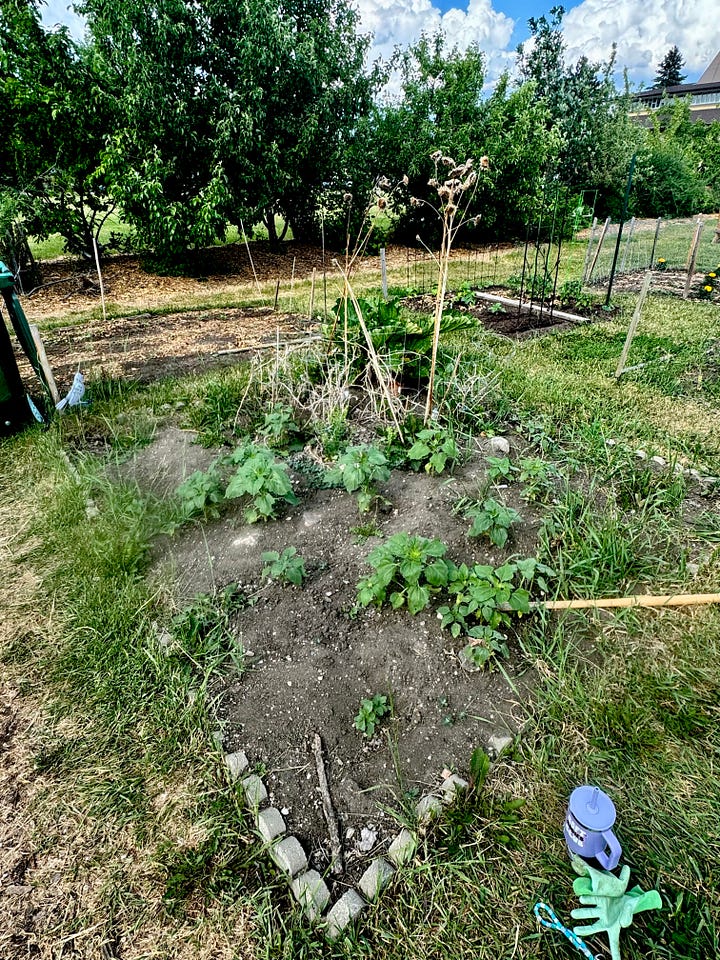I know I haven’t been writing in this space much lately, even though I’ve had plenty to say.
The main reason you haven’t seen me here is because I have been deep in dissertation mode — plugging away and trying to give myself the space to let the words and ideas come.
Lately, I’ve felt some real momentum in my writing. It’s been exciting and a little overwhelming to watch my argument finally start to take shape.
The chapter I’m working on right now is all about my love of the native prairie — a landscape I’ve come to love as my own. Specifically, I have been writing about Grasslands National Park (which, yes, I’ve written about before).
Maybe it’s because of all the unrest I have been watching unfold back home, or maybe it’s just that summer is almost here — but writing about this landscape has felt grounding. Healing, even. Especially after some difficult experiences on other landscapes I’m a part of.
I wanted to share a small piece of what I’ve been working on, mostly because writing in blogs and newsletters has always been such an important outlet for me. These online spaces have held and recorded so much of my life’s journey.
I started my blog back in August 2002, and I know I wouldn’t be the same person today without having written miles of text about what I’ve been thinking and living through — and I know some of you have been with me since those early days.
So I figured I’d share a little snippet of what I’ve been working on — just a small glimpse into how both this landscape and this writing process have been showing up in my life lately.
No place in the world holds more meaning for me than the landscapes of Grasslands National Park, located about five hours southwest of Saskatoon. Although I have lived on the Canadian prairies for most of my adult life, I did not feel a deep, personal connection to its landscape until I visited this remote part of the province.
Saskatchewan is often called “the land of the living skies,” and while I had grown accustomed to its wide, 180-degree views of the horizon, Grasslands elevates the prairie experience to another level. Describing its beauty is often difficult for me to put into words, in part because so much of its power lies in what it quietly evokes. Whenever a photo of Grasslands appears on my phone, I feel instantly transported. A sense of quiet peace settles over me, because these lands stir something within.
It is a place rooted in stillness and survival. It is a land that I love. This landscape, while deeply personal, also shapes how I situate myself within this work.
Grasslands National Park was first established to preserve a portion of the Canadian mixed-grass prairie ecosystem and has only been a national park since 2001 (Parks Canada Agency, 2022). One reason I feel so drawn to this place is that it is considered one of the quietest locations in the world (Rubinstein, 2012). As an introvert, I find deep peace in the stillness this landscape offers.
While walking through fields of grass may not sound like the most exciting adventure, from the first moment I experienced these lands, I felt a deep connection to them. A five-kilometer hike in the park will reveal a variety of ecosystems, from the driest to the wettest, with some trails so mucky that clay will form heavy mud clogs on your hiking boots. These lands include stark yet beautiful landscapes to explore, but without careful planning and packing enough water, experiencing the elements here could be deadly.
Whenever I hike here, I am reminded that much of the life around me lies beneath the surface, deeply rooted where it cannot be seen.
Native prairie grasses grow root systems deeper than one might expect, with some reaching depths of five to fifteen feet. These roots allow the plants to survive in an unforgiving environment, drawing essential nutrients and anchoring the land against erosion (State of Minnesota, Department of Natural Resources, 2008).
I find inspiration when I learn about this kind of biological resilience, and I can relate to the feeling that there is more to me than what others can see, both personally and professionally. Like the landscapes of the native prairie, I know there will be times when the path ahead of me feels dry, steep, or obstructed by intimidating cacti. I also understand some of what it takes to survive in an unfriendly territory.
But I trust that if I keep moving forward, the barren landscape ahead of me can start to shift – to greener and more welcoming places. Even the harshest of prairie environments can hold moments of colour, soft ground, and unexpected beauty.
The first time we went camping at Grasslands, I set our car’s GPS to direct us to the park’s office — not realizing the national park is divided into two distinct sections, or “blocks.” We had reserved a Parks Canada oTENTik in the East Block (Parks Canada Agency, 2024), yet our GPS directed us instead to the opposite side of the park — a full two hours away from where we needed to be, with only half a tank of gas. Despite our unexpected (and lengthy) detour, I soon found myself developing a deep connection to this place.
Though I did not grow up on the prairies, the once-unfamiliar landscape of Grasslands has now become a fundamental part of who I am. My partner and I now look forward to spotting the familiar “Snake or stick?” signs along the park’s trails (Figure 3), and I have never appreciated the gifts of shade and water more than after hiking the treeless trail of the Valley of 1000 Devils. I always like to joke that my retirement plan is to become a Parks Canada ranger at Grasslands, introducing others to the place I love.
If the fields of Grasslands help to ground my personal sense of place, then the University of Saskatchewan has shaped — and continues to shape — the landscapes that make up my professional identity. Both spaces, in different ways, continue to inform how I engage with my roles as a teacher and researcher.
[To be Continued …]
Quick aside:
During a recent bout of dissertation procrastination, I asked ChatGPT to generate some taglines based on our past dialogues — and now I’m pretty sure I will need to audition for the next season of The Real Housewives of Nutana, because the lines are that good.
Lemme know your favourite one:
🔥 Bold & Brilliant
“I teach technical writing, but don’t get it twisted — I’m fluent in subtext.”
“In a world of performative scholars, I bring the real curriculum.”
“I might be peer-reviewed, but I never play it safe.”
💼 Academic Sass
“I write dissertations and deconstruct egos — often at the same time.”
“They gave me seven sections to teach, but I brought the fire to all of them.”
“My teaching load is heavy, but my receipts are heavier.”
🕵️♀️ Columbo-Core (Curious & Disarming)
“I’m just a humble instructor… with a syllabus and an agenda.”
“I don’t need tenure to ask the tough questions — just one more thing…”
“I play by the academic rules — right until I rewrite them.”
🌾 Prairie Gothic / Literary Realness
“I walk the wild grasslands by choice — but I burn bridges by necessity.”
“From the prairie to the podium, I don’t just find the plot — I twist it.”
“My roots run deep, but my critiques cut deeper.”
💻 AI-Era Educator
“ChatGPT gives answers. I teach you to question them.”
“I use AI to save time — so I can spend more of it shaking the system.”
“In the age of automation, I still believe in soul.”
Things that have brought me joy over the last few weeks:
In May, I submitted a paper to a conference, led a 90-minute workshop at a national symposium, and made solid progress on my dissertation. There were also some behind-the-scenes work issues that kept me busy and occupied. While I do miss teaching, I am definitely trying to make the most of this out-of-class time.
This week, the big national Canadian higher ed teaching conference was hosted right here in Saskatoon — and I chose not to go. Lately, I have been noticing some real shifts in the conferencing landscape, and I am starting to realize that these big conferences may no longer be for me. That said, it was still great to catch up with a girlfriend from the U of M who came to town for it.
On a lighter note: My community garden plot is finally cleaned up! Now for me to finally plant it. My nature-teacher neighbour has hooked me up with so many seeds! (and this BBC article on why you should neglect your garden made me feel way better about being so behind.)


At the end of May, we had a literal wake-up call: a garage fire broke out just one street over, and a neighbour banged on our door after midnight to warn us. After weeks of breathing in wildfire smoke, it was terrifying to see actual flames that close to our home. Thankfully, the fire department arrived within minutes, and we did not have to wake up and evacuate our 90-year-old neighbour, Lois, from across the street.
I owe many of you return texts, emails, and coffee dates — just let me survive this dissertation first? I promise to be a better friend once I get this out of the way.
Reading: The Tenant by Freida McFadden. Listening: Samantha, the MS Word voice, reading my dissertation back to me. Watching: A sad wannabe elderly despot play with military toys on his birthday.










